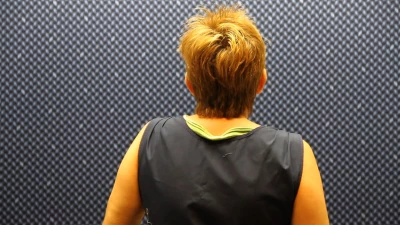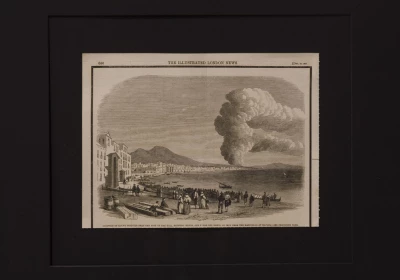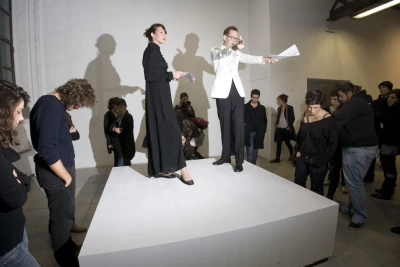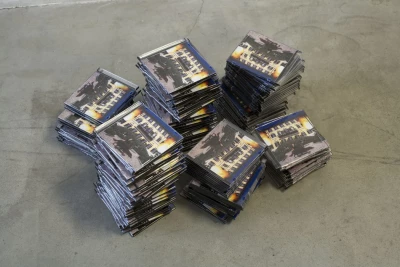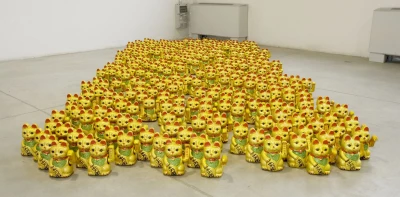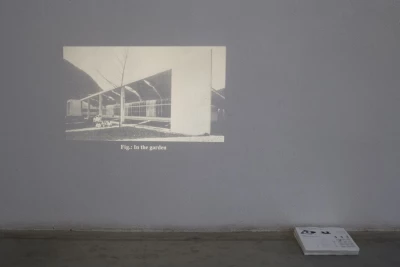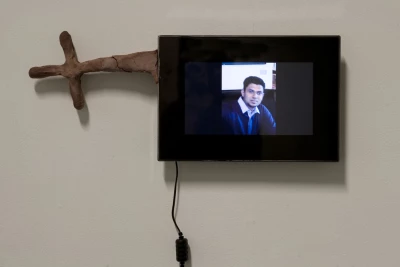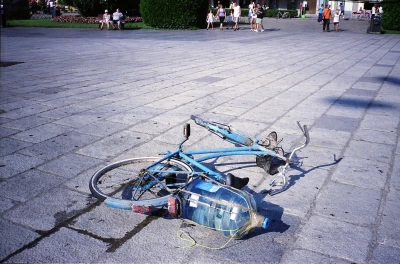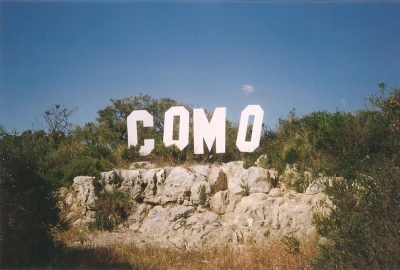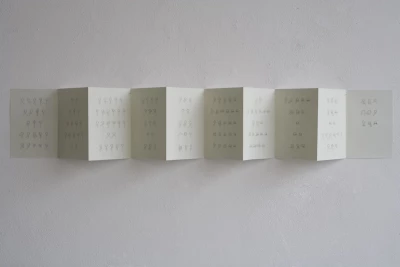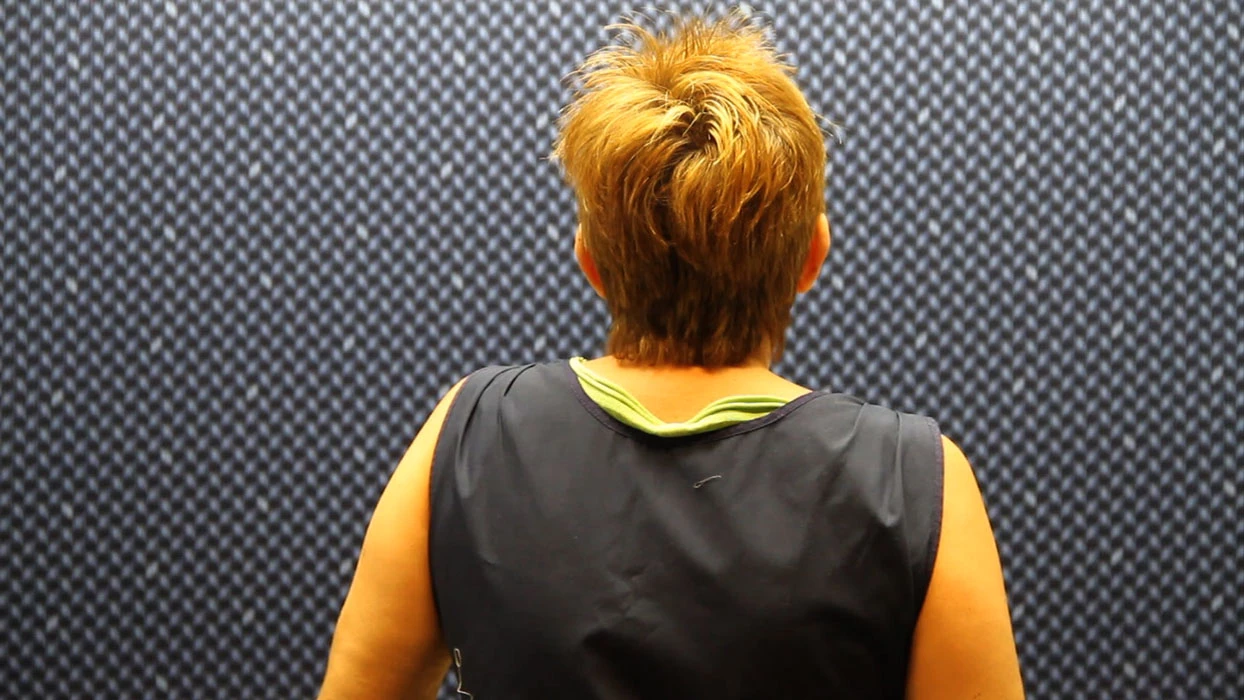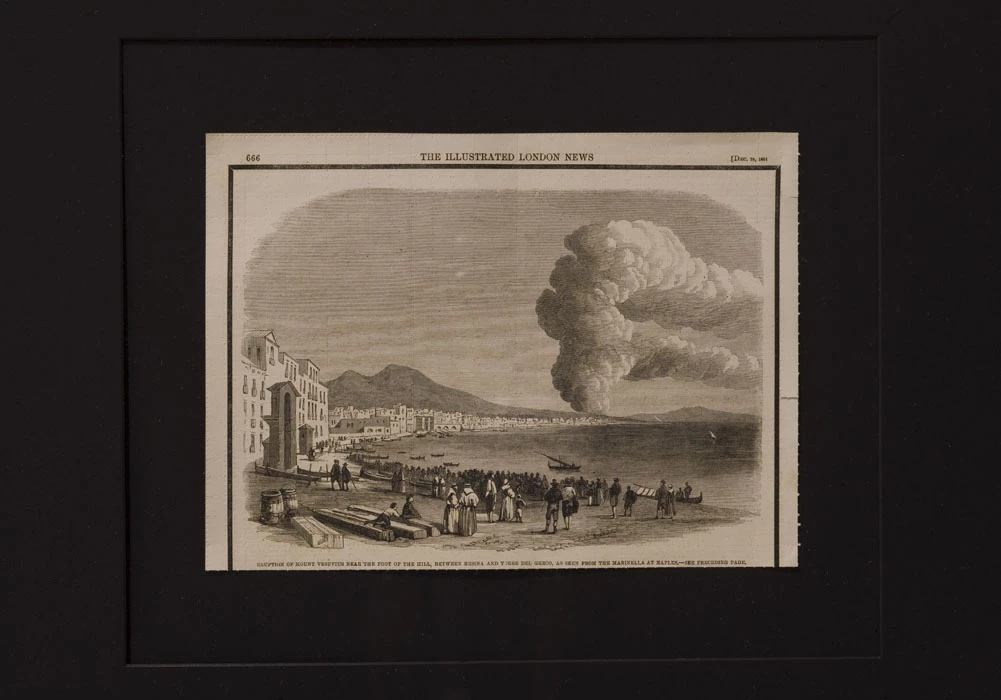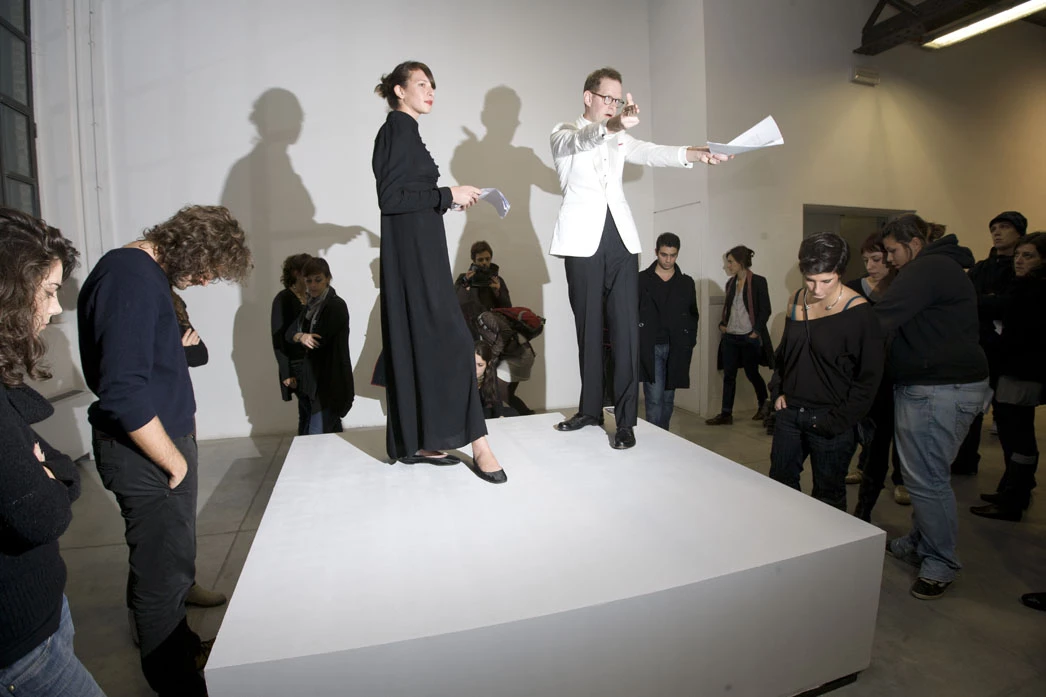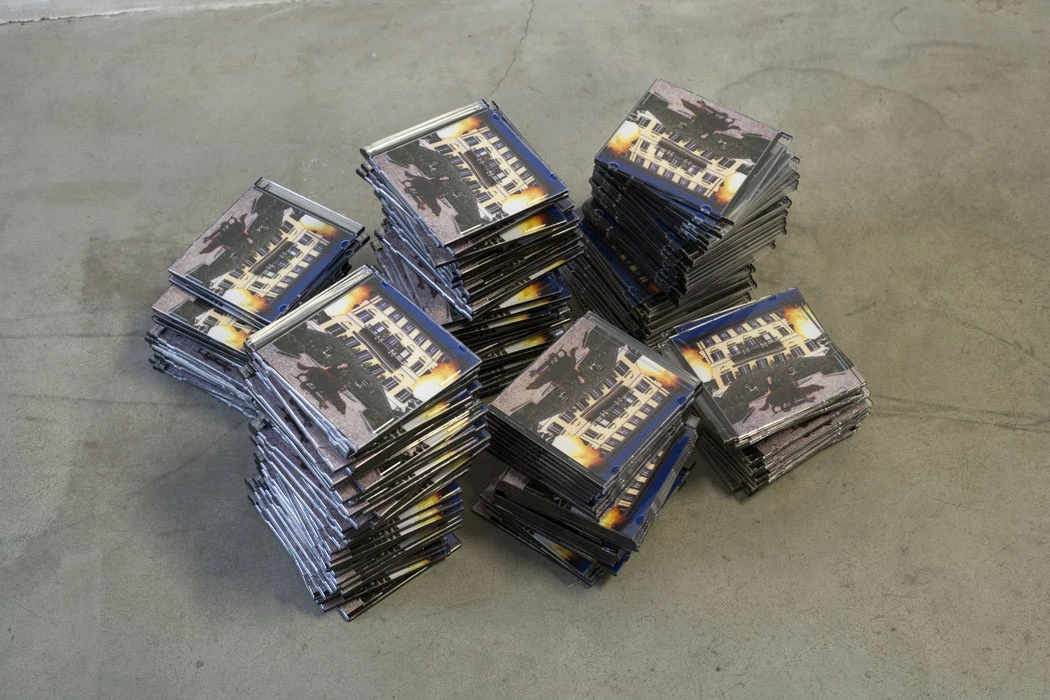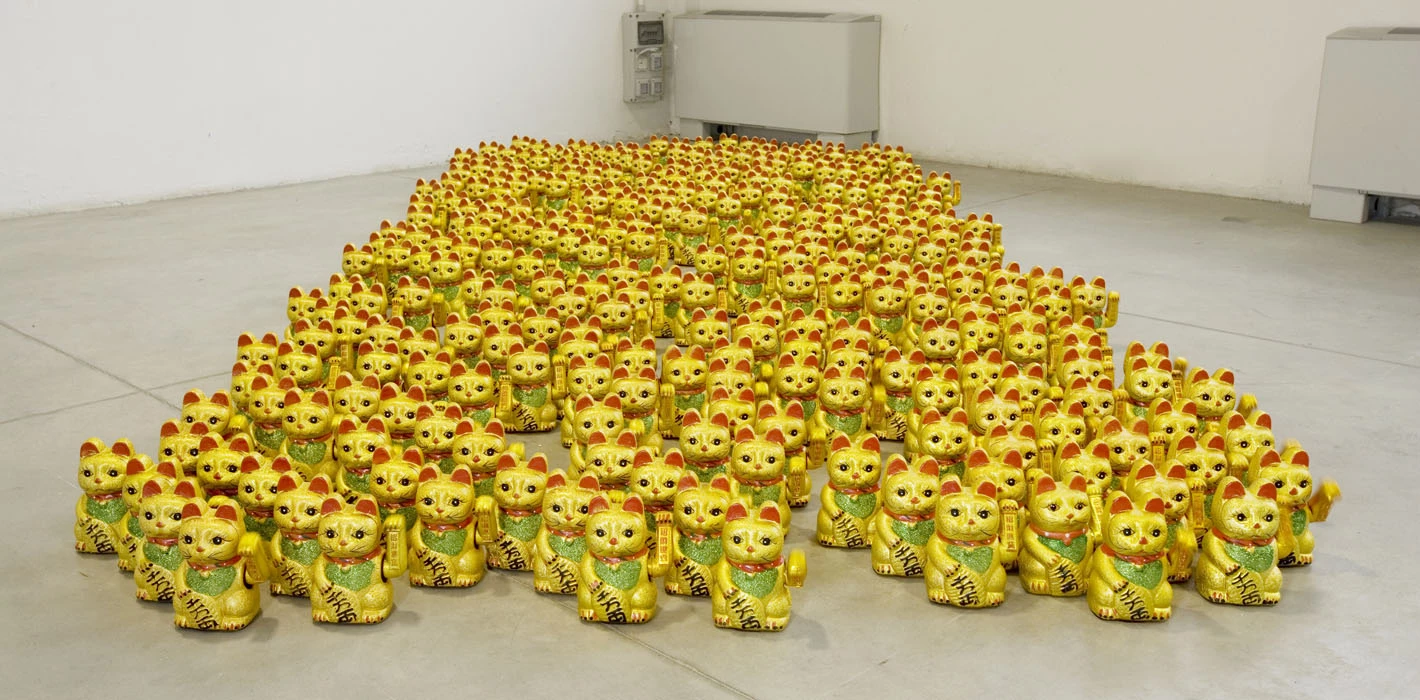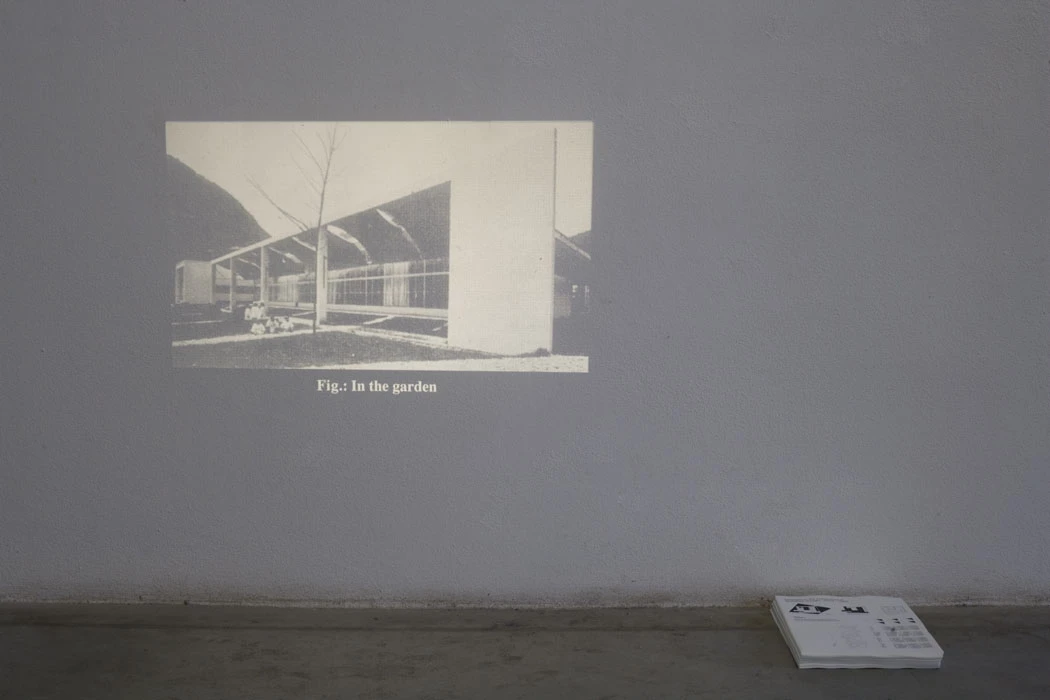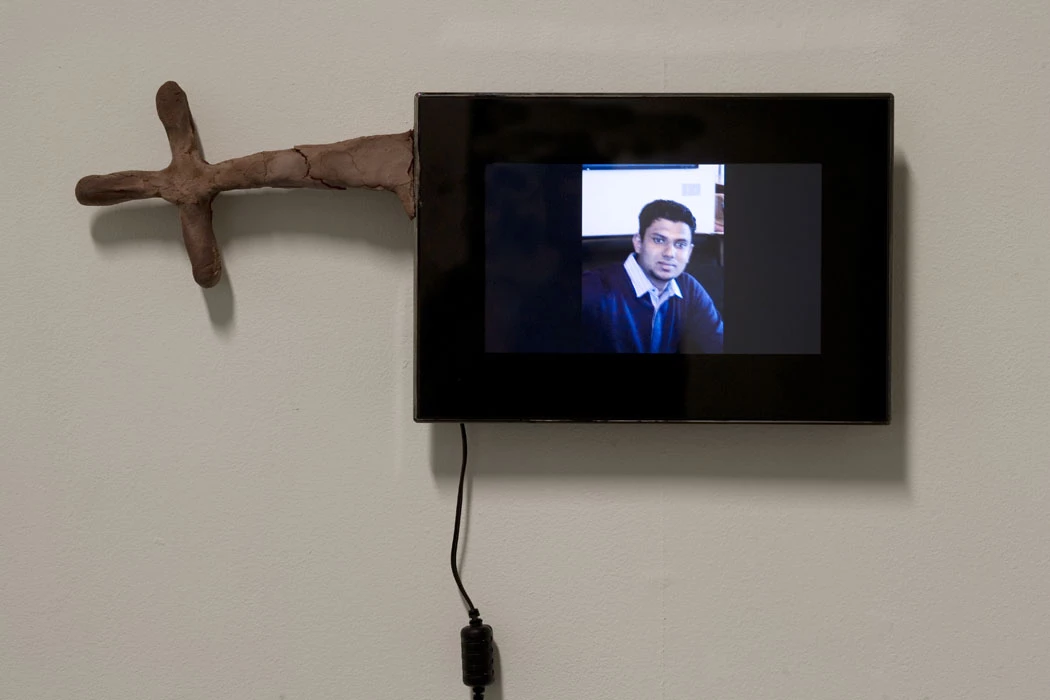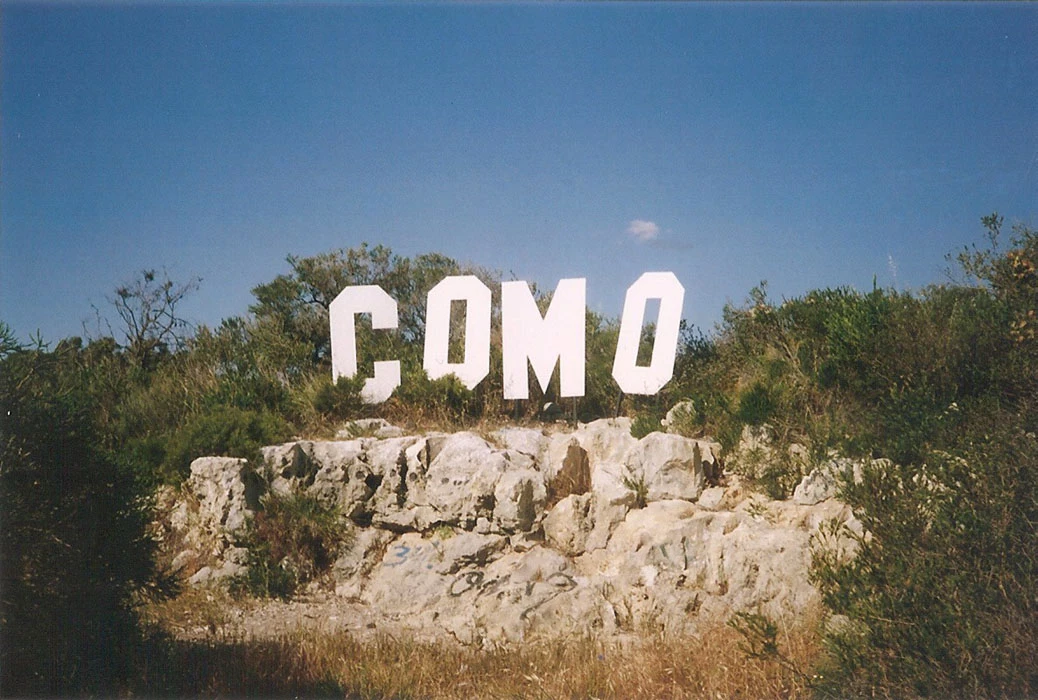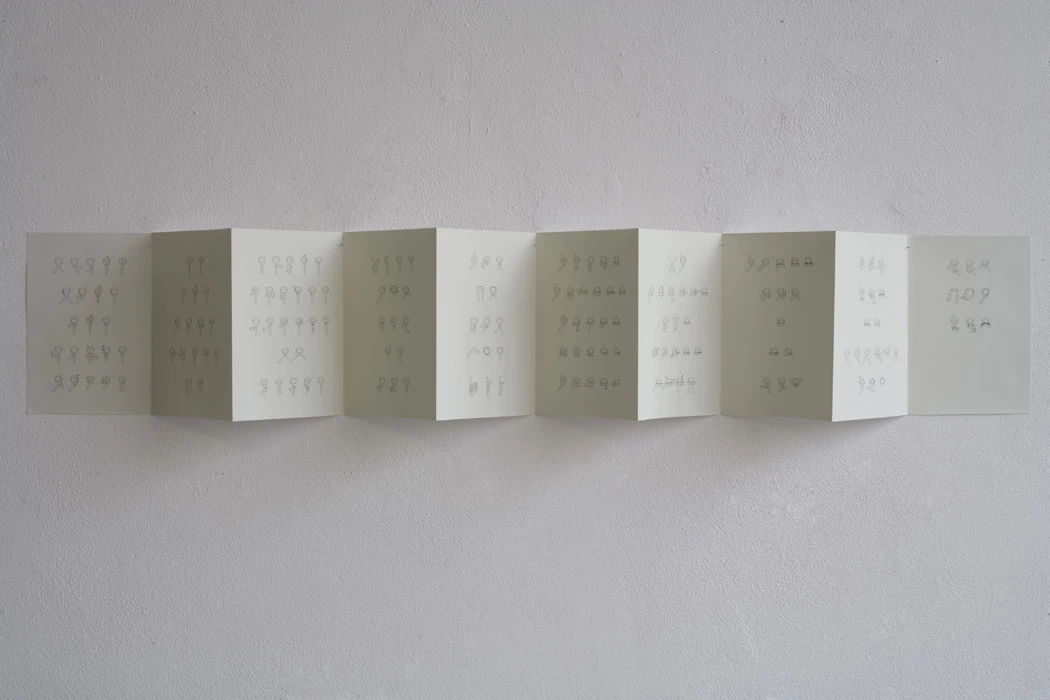Give and take
CURATED BY
Anna Daneri e Cesare Pietroiusti
TUTOR
Hans Haacke
IN COLLABORATION WITH
Viafarini
WITH THE SUPPORT OF
Epson Italia
From 03.11.2010 to 20.11.2010
End-of-course exhibition of the participants in the XVI edition of the Corso Superiore di Arti Visive of the Fondazione Antonio Ratti, directed by Annie Ratti and this year led by Hans Haacke as Visiting Professor.
The exhibition features works by the nineteen artists who attended the workshop in Como in July: Walter Benjamin Smith (USA), Julia Brown (USA), Antonia Carrara (ITALIA), Danilo Correale (ITALIA), Abbey Shaine Dubin (USA), Laura Duran (COLOMBIA), Birte Endrejat (GERMANIA), Fausto Falchi (ITALIA), Till Gathmann (GERMANIA), Adelita Husni-Bey (ITALIA), Kentaro Ikegami (GIAPPONE), François Lemieux (CANADA), Eric Martijn (OLANDA), Ludovic Méhauté (FRANCIA), Emily Morant (AUSTRALIA), Elaine Marianne Reynolds (IRLANDA), Fabrizio Sartori (ITALIA), Elisa Strinna (ITALIA), Oriol Vilanova (SPAGNA).
The exhibition, organized across three spaces at the Fabbrica del Vapore, offers the opportunity to explore the work of the international artists selected for the course, starting from the projects developed during the seminar experience with Hans Haacke. Give and take presents installations, performances, videos, photographs, and drawings that approach the themes addressed together with the Visiting Professor in different ways. During the workshop, Hans Haacke analyzed together with the young artists the various relationships between them and their places of origin; a similar investigation was also directed toward Como and the context in which the artists worked, a context from which significant elements were taken. The course was an occasion to reflect on the concept of “specificity” of a place and “significance” of a particular object, image, practice, or action.
On November 3 at 6:30 pm, during the inauguration, the names of the three winners of the Premio Epson FAR for artistic research will be announced. Now in its fifth edition, the prize is awarded by a jury composed of Carla Conca (Business Manager Videoprojectors at Epson Italia), Annie Ratti (Director of the Corso Superiore di Arti Visive), and Andrea Lissoni (art historian and curator at Hangar Bicocca).
The prize was established in 2006 thanks to the contribution of Epson Italia, which decided to support young artists participating by awarding the works of greatest interest from the point of view of visual experimentation.
The exhibition is also an opportunity to present the publication related to this year’s course. A genuine collective project, discussed and developed during the course and divided into sections curated by the various working groups. Publication and distribution are by Mousse Publishing.
With the patronage of Comune di Milano and Fabbrica del Vapore
Bio
Julia Brown
She holds an MFA from CalArts and a BA from Williams College. In 2006, she received the Dedalus Foundation Painting Award. Her work has been exhibited at: Real Art Ways, Hartford; PARKHAUS im Malkastenpark, Kunsthalle Düsseldorf; LACE, Los Angeles; LMAK Projects, New York; Greenleaf Gallery at Whittier College; 507 Rose Gallery, Los Angeles; Artists Space, New York. She has also recently attended the Skowhegan School of Painting and Sculpture and the Fine Arts Work Center, Provincetown.
Antonia Carrara
Born in Rome in 1982. Lives and works in Paris.
Education: 2009/2010 - LE FRESNOY, studio international des arts contemporains. DNSAP, ENSBA, Ecole Nationale Supérieure des Beaux Arts de Paris. 2008 - M.A. ENSAD, Ecole Nationale Supérieure des Arts Décoratifs.
Exhibitions: 2010 - «Ellypse», Moulins de Paillard, France; «Panorama 12, Soft Machine», Le Fresnoy, France
2009 - «The common player», Mediamatic Bank, Amsterdam; «Contemporary Flânerie: Reconfiguring Cities», Oakland University
2008 - «Video Bardo», Centre Culturel Borges, Buenos Aires; «Plektrum Festival of Visual Sound», Tallinn, Estonia; «One Minute Film & Video Festival», Aarau, Switzerland
2007 - «10 jours 10 artistes 10 vidéos», Palais de Tokyo, Paris; «Les yeux grands fermés», La Générale, Paris
Danilo Correale
Danilo Correale’s work is focused on studying the social impact of images and the power that some realities within the cultural industry, often inscribable within the “pop archive,” have to impose a collective memory. His research investigates possible strategies of resistance to forms of propaganda mediated by visual culture and the proliferation of false mythologies.
Correale was born in Naples in 1982, graduated in Sculpture in 2006 from the Accademia di Belle Arti di Napoli, and in 2009 from the Visual Arts and Curatorial Practice course at Naba in Milan. He has participated, among others, in the symposium “What is real,” ICP Education Department, New York, and in the residency program of the Spinola Banna Foundation and the self-managed space PIST in Istanbul.
Abbey Staine Dubin
Graduated from Columbia University in New York, she earned a Master of Fine Arts at UCLA. She is among the collaborators of the project “Our Literal Speed,” a series of events at the intersection of art and history in Europe and North America. She has participated in group exhibitions in New York, Los Angeles, and London. Her current projects explore structures of authority through installations, video, and performance.
Laura Duran
Born in Bogotá, Colombia, she currently resides in Miami. Collaborative work with the group “Baby Names,” which organizes one-night exhibitions inside motels, is currently an important part of her artistic practice. Her research, originating from a background in painting and sculpture, has moved toward a practice based on processuality and forms of collaboration.
Birte Endrejat
With drawing as her background, she observes and explores situations, developing experiments that sometimes go beyond the understanding of her artistic work. She is a member of the artist collective marc. She currently lives in Berlin and studies Visual Art at Hochschule für Künste in Bremen. Her works have been exhibited in Germany, Montréal (Canada), Nagoya (Japan), Latore (Pakistan), Botkyrka (Sweden), Zurich (Switzerland), Bangkok (Thailand), and Cambridge (USA).
Fausto Falchi
Graduated in sculpture from the Accademia di Belle Arti di Napoli, he is currently enrolled in the Master's degree in Design and Production of Visual Arts at IUAV in Venice. He has participated in workshops with Jimmie Durham, Tania Bruguera, Marjetica Potrc, Antoni Muntadas, Benjamin Weil, Ciriaco Campus, and Mino Trafeli. In 2004, he founded the artistic collective “Cerbero” (active until May 2009), with which he created numerous public art interventions, combining technology and performance. Currently, his artistic research is focused on the endemic problem of the relationship between man and machine and the investigation of social aspects of technology. He is a member of the collective “Sottobosco.”
Till Gathmann
Artist, typographer, and book designer, he lives in Leipzig, Germany. His work investigates issues related to narrative, exhibition design, and the semiotics of history. He has produced numerous books in collaboration with artists such as Peggy Buth, Sven Johne, Olaf Nicolai, Clemens von Wedemeyer. He has taught typography at the School for Visual Arts in Leipzig and is co-founder of “Soir Critique,” a series of independent lectures and seminars at the same school that have addressed topics such as Situationism, NoArt, Samuel Beckett, and the concept of realism in cinema.
Adelita Husni-Bey
Italian-Libyan artist, born in Milan in 1985, she moved to London in 2003, where she is attending a BA in Fine Arts at Chelsea College of Art and Design, as well as an MA in Sociology and Photography at Goldsmiths. Her work addresses the ways of constructing collective memory, the articulations of a possible grammar of resistance, and forms of contestation of geography through the use of film, photography, and painting.
Kentaro Ikegami
Born in Tokyo, Japan, in 1986. He obtained a BFA in sculpture and installation at Ontario College of Art in 2008 and an MA in Fine Art Media in 2010. He has lived in Hachinohe, Yokohama, and Tokyo, as well as Washington D.C., Toronto, and London.
François Lemieux
Born in 1979 in Québec City. Since 2007, he has developed an artistic practice referencing art, architecture, and design. His work implies a critical commentary on economic mechanisms, as well as the relationships existing between objects, the means of their production, and the circumstances of their presentation and reception.
Eric Martijn
Sculptor, lives in Amsterdam. Rather than considering spatial relationships as a given, his work attempts to transpose reality through direct intervention, thus questioning existing parameters and the experience of space. His intervention can be imposing or subtle but in any case attempts to create a new set of spatial agreements in which architecture ceases to be an imposed structure and becomes the object of measurement calibrated on the human scale. This new experience engages the observer in a dialogue, within which a new level of understanding of the surrounding environment can form. This process can be called “spatial engineering.” Every material is carefully chosen both conceptually and sculpturally. His inspiration takes shape from the specific materials that constitute a space, as well as from social interactions created within it: materials are sculpted and recombined to create new realities.
Ludovic Méhauté
Born in 1980 in Saint-Brieuc, France, lives and works in Berlin. Working both individually and collaboratively, the artist uses public spaces as sites for experimentation. Objects collected during his territorial reconnaissance are re-interpreted as artworks through photography, video, installation, and drawing. This process is central to his exploration of how humans perceive natural and social phenomena.
Emily Morant
Her artistic practice is focused on exploring ways to distinguish the transition between the idea of “space” and that of “place.” The artist feels the need to develop a broader interest and curiosity about the area where she lives, due to the potential experience of alienation from her immediate surroundings. Her intent is to generate a broader level of awareness regarding the perception of the relationship between public and private, between inside and outside, between reality and fiction, as examples of the growth of an identity linked to a place. Through an exchange between herself and the landscape, the artist attempts to provide a playful critique of the concept of suburban periphery, and to inspire ephemeral actions for the benefit of others aimed at enriching the experience of a given place.
Elaine Marianne Reynolds
She studied at the National College of Art and Design in Dublin and at the University of Ljubljana, Slovenia. Graduated in 2007, she currently lives in northwest Ireland. Her artistic practice is strongly oriented toward research and design, and tends to use live action and video media. Some carefully chosen locations, with their intrinsic qualities, are an essential element of this research. Often her works combine traces of free associations with historical and scientific truths. Cause/effect, repetition, and cyclicality are recurring themes. The documentation of unique events is interpreted in the broadest sense and can take the form of text, image, object, or experience.
Fabrizio Sartori
Born in 1980 in Rome, where he still lives. After studying architecture, he deepened his research in the field of visual arts.
Some facts to know about him:
suffers from vertigo
loves animals but not invertebrates and arachnids
a traveler by nature, he loves moving around, even just a little
The media and techniques he uses are varied, but he has repeatedly acknowledged both to himself and others a preference for a two-dimensional vision.
Walter Benjamin Smith
Born in the United States, he has been working in New York since before September 11.
Elisa Strinna
Born in Padua in 1982; after graduating from the Accademia di Belle Arti di Bologna, in March 2010 she obtained a specialized degree in Visual Arts from IUAV in Venice. In her work, the artist tends to develop various areas of research, both stylistically and conceptually; addressing different media and materials, in recent years she has focused particularly on language and the possibilities of translation, studying various ways to convey history. In 2008, she was awarded one of the studios of the Fondazione Bevilacqua la Masa in Venice for one year. Among the main exhibitions: “Elusive” (2010) curated by Jimmie Durham, RAM, Rome; “Eppur si Muove” (2009) curated by Inti Guerrero, Julia Klaring, Pieternel Vermoortel, Fondazione Sandretto Re Rebaudengo, Guarene; “OPERA 2009,” curated by Mara Ambrozic and Stefano Coletto, DOCVA, Milan; “Iuav al MAXXI” (2008), curated by Cornelia Lauf and Angela Vettese, museo MAXXI, Rome.
Oriol Vilanova
He is an architect graduated from ETSALS in Barcelona.
He is interested in the processes of collecting, performing, and publishing. He has participated in group exhibitions including “Guia secreta de la Ramala”, Virreina, 2010; “Have a look! Have a look!”, FormContent, London 2010; “The Malady of Writing”, MACBA, Barcelona 2009, as well as exhibitions at Afterall Online, Nogueras Blanchard Gallery, Casa Encendida Madrid, Espai Zer01, Circulo de Bellas Artes de Madrid, Museu Abelló, Centre d’Art Roca Umbert, La Capella, La Sala d’Art Jove, and within programs such as Barcelona Producció, Injuve, Sant Andreu Contemporani, and Idensitat. He is working on upcoming projects at CA2M, Virreina, and CNEAI Paris. In collaboration with French curator Thomas Boutoux, he directs the editorial eff.
Works
Julia Brown
Live feed
2010
Color video projection in loop
Footage of a control station and the operator responsible for the printing process in an Italian luxury silk fabric factory; that is, “the instinctive and meditative attitude towards privacy” (Glück), before “Leaving the factory.”
Antonia Carrara
Secret Portrait with W.B.
2010
Installation, double projection (super8 film transferred to DVD / audio), loop, 5'
With Walter Benjamin Smith
Filming: Antonia Carrara and Adelita Husni-Bey
The young Walter Benjamin, accidentally sharing the philosopher's name, takes a guided tour of artist residences built on Isola Comacina in the 1930s and commissioned by Mussolini. These buildings, long abandoned, have just been restored. A voiceover, freely inspired by the texts of painter M.Radice and historian R.G. Collingwood, discusses the relations between rational and irrational, the science of history and nature.
Danilo Correale
The fact has been announced...
2010
Various materials, woodcut, audio track
“The Illustrated London News” was one of the first magazines to understand the importance of combining textual narration with iconography. Long before photographic image reproduction processes could enter printing systems, this publication featured picturesque woodcuts of unexplored places, news events, historical happenings, clashes, and naturally various disasters. Great attention was given to the narrative of the Event, with even more extensive space dedicated to images and texts on the subject. The text in question is a fresco of an era where nothing is sensational, everything seems to happen as a natural evolution of things; however, the tourist attraction created by the event is already evident. The Fact refers to a Vesuvius eruption, at a point different from the main crater, specifically between Herculaneum and Torre del Greco (the place where I grew up), where currently about three hundred thousand people live. There is no narrative capable of telling the implications of living in such a defined area, nor a methodology to represent it; the collective experience is the experience of the individual, an almost impossible translation.
Abbey Shaine Dubin
Our Literal Speed
2010
Installation
This multimedia installation has, as its starting point, the concept of literality. It consists of a base, a stool, and a group of people. From the juxtaposition of relationships emerges a learning with a vernacular quality.
Laura Durán, Fabrizio Sartori
La Soledad/La Solitudine
2010
Video-installation
Laura Pausini (Faenza, May 16, 1974) is an Italian singer and songwriter. She began her career in 1993, winning the Festival di Sanremo in the Newcomers category with the song La solitudine[2], and is considered one of the most popular Italian singers today[3]. She reached the international music market, recording songs in Spanish, Portuguese, English, and French, achieving important successes in many Latin American and European countries[3]. Throughout her career, she has sold about 70 million records[3] and received several international awards, including a Grammy Award, won on February 8, 2006, for Best Latin Pop Album of the year with Escucha[4][5] and 3 Latin Grammy Awards for Best Female Pop Album, won in 2005 with Escucha[6][7], in 2007 with Yo canto[8][9], and in 2009 with Primavera anticipada[10][11]. In 2006, she was awarded the title of Commendatore of the Italian Republic[12][13][14].
Laura Durán
Gob'ble-dy-gook'
2010
Stacked compact discs, sound, paper
Gob'ble-dy-gook': pompous and verbose speech; meaningless writing
Birte Endrejat
dedicated t. (edition, A3, BIO TOP 3 / 80g)
2010
The time dedicated to creating a work will be converted into the measure of my own manual labor. The produced result is offered to the exhibition public, who can take it away. Each sheet of paper bears the phrase, oscillating between hope and despair.
Fausto Falchi
Sciopero a gatto selvaggio
2010
Installation, 300 golden maneki neko on the floor
The wildcat strike is a form of workers’ struggle practiced in the 1960s and 1970s with sudden and hardly predictable actions; it aimed to paralyze production lines in large industrial plants. In serial production sites, based on the chain system, workers sabotaged the production line by alternately stopping work. The maneki neko, generally used as good luck charms in Eastern tradition, stage a collective protest subverting their function as individual pieces. Presenting themselves as a multitude, obsessed by incessant ticking, they burst into the space with a demand: they go to correct luck. (Pasquale Nunziata)
Till Gathmann
The Fascist Kindergarten
2010
81 slides, poster
The Fascist Kindergarten presents some notes on the relationship between fascism and architecture, Mussolini and Terragni, with particular reference to the Asilo Sant'Elia in Como.
Till Gathmann
Traçage automatique
2010
Pencil on floor
Drawing by Francesco Ambrosio
Traçage automatique was drawn by a child on a tricycle, on which a pencil was mounted.
Adelita Husni-Bey
Lethe
2010
S8 transferred to DVD, loop, 4'20”
Audio project by Joe Zietlin
Courtesy Galleria Laveronica, Modica (RG)
Lethe is based on archival research conducted in summer 2010 in the area of Lake Como. Through interviews with World War II historians, articles, books, documents, and commemorative plaques, an attempt was made to reconstruct the exact geographical place of partisan executions in the area between Porlezza, Monte Bisbino, and Rampogno. Lethe, the river of oblivion and forgetfulness in Greek mythology, is a reflection on the speculative nature of reconstructions based on historical information and the mythologizing process they produce. Each scene shows the im/possibility of ‘re-living’ infinitely the last 10 seconds of a partisan's life, capturing his defeat, denial, and the prolonging of his death through the bloody mirror of the film camera.
Kentaro Ikegami
The Enemy Is Inside
2010
Digital frame, decoration, digital photographs
The Enemy Is Inside is a collection of photographs taken by an anonymous Sri Lankan in various Italian locations. It is presented in a digital frame with a clay cross attached on the side.
François Lemieux
Untitled (welcome the crowd and)
20.07.2010 – 26.10.2010
Eric Martijn
Untitled
2010
Digital projection of the “no posting” sign photograph (Via Ceresio 9, Milan) on the walls of the exhibition space.
“No posting” is the injunction of the sign posted in Via Ceresio, Milan. Built in stone and firmly cemented within the urban architecture, the sign tries to fix a potential space outside institutional control (‘nonstate space’, Scott). In doing so, it effectively proposes a rule of the type: “do as I say, not as I do.” Through this paradox, the State reveals the true nature of its power. Extracted from its urban context, the sign is now projected onto the “untouchable” wall of the exhibition space.
Ludovic Méhauté
Le voyage du vélo-poisson et de la fontaine / The travel of the fish-bicycle and the fountain
2010
Bicycle, fountain, monitor, video, iPhone, color, audio, 6' 40”
Following the discovery of an abandoned bicycle on the shore of Lake Como, the artist focused interest on this bicycle and on the lake where it had been left for months. The bike was then used to carry lake water to the center of Piazza Cavour, where the water gradually dispersed. A re-creation of a fountain in the empty space of the square, whose history is linked to the lake.
Emily Morant
Welcome to Como, 6152
2010
Photography
Emily Morant’s artistic practice converges sculpture, performance, and photography, with a cynical, ironic, and inevitably futile investigation of how to put on the same level the culture of Western Australia’s periphery and an international scene. The artist’s attention focuses on the relationship between the individual and the landscape, and on feelings of displacement and insignificance that this relationship can evoke.
Elaine Marianne Reynolds
All…or virtually All
2010
Handworked silk fabric, mahogany frame, text, handmade packaging and labels. The hybrid flag was handwoven in Ireland using silks imported from various locations worldwide. The woven work was then brought to Milan where the final production stages were completed and the label “Fabbricata in Italia” was applied. This gesture is meant as a response to the economic implications and senseless standards regulating the international product labeling system. In the United States, for example, the law establishes that to carry the label “Made in USA,” “all or virtually all” production stages must occur in the country. In October 2010 the Italian government enacted a new law stating that if at least two production stages are completed in Italy, the product can be labeled “Made in Italy.” All…or virtually All also refers to the Como industrial tradition of sericulture and silk fabric production and to how such industries have had to adapt to new conditions of the globalized economy. To compete internationally, it has become necessary to import silk yarns and fabrics already treated in China. These silks can then, undergoing only dyeing and printing processes in Como, be labeled “Made in Italy.”
Fabrizio Sartori
We don't know today what could happen tomorrow (remedying)
2010
Video DVD, 15'
I built a small shelter inside a cave at an archaeological site, closed to the public at night. I spent the whole night drawing and sleeping. I came out only when the sun rose again. My goal was to see and record how the dawn light would change the ancient Roman ruins. This would be the most beautiful and ecstatic moment to observe those ruins. It happens only when the space is closed and empty. It happens by itself and for itself. No one can see it.
Walter Benjamin Smith
THE AMERICAN
2010
Backlit prints, metal
Walter Benjamin Smith
Soft Division
2010
Metal, chain, hook for sadomasochistic practices
New finalization for a 'new age' seat by an agnostic yoga-appropriating freelance representative of the adult 'cognitariate' on a sculpture base
with soft walls
for the American genitals of Hans Haacke
made without walls
Walter Benjamin Smith
The Costumi di Mezzo Canvass (L'inchiesta dei costumi di mezzo)
2010
Two Italian university-aged individuals, uniforms, text, clipboard, pamphlets
Performance.
Thursday, November 4, 2010, from 2 pm to 3 pm, at the intersection between Corso Buenos Aires and Viale Tunisia
Elisa Strinna
Polvere
2010
Video-installation, 11'
In the past, Veneto was subject to frequent emigration phenomena due to poverty and unfavorable economic conditions. Between the unification of Italy and the early twentieth century, it was one of the regions with the highest number of migrants: several million Venetians left their homeland to move worldwide in search of fortune. Those who never returned helped create new communities where they settled, often coexisting cultures and traditions of different origins. Polvere arises as a comparison between today’s reality of Northeastern Italy — a land recently characterized by sustained economic development and consequently a destination of migratory flows — and its past. A short video tells the experience of a young woman, daughter of “those who left,” engaged in visiting the “land of origin” in the desire to find a sign of belonging to her roots’ community. The protagonist’s personal memory confronts a collective repression.
Oriol Vilanova
Inutile et Significatif
2010
Print on paper
Oriol Vilanova
Possibilities of Repetition
2010
Photography
Symbolic messages and social representations: toujours la même chose. The dialectic of repetition is simple and easy, since what repeats has already been, otherwise it could not be repeated. Nonetheless, the fact that it is the repetition of something that has already been is what gives novelty to the repetition itself. It can be variant, thus including a difference within it. Useless and unnecessary, standardization is what transforms a certain environment into a mere pattern.
